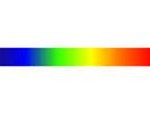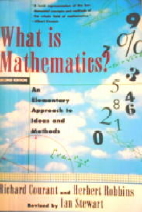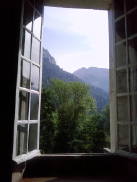 I think often about the continuity of things – about the smooth progression of structure, that is the stuff of life, from the microscopic to the macrocosmic. I was reminded, again, of how often I see things in terms of continuums when I listened online to a lecture given by Gregory Chaitin in 2008. In that lecture (from which he has also produced a paper) Chaitin defends the validity and productivity of an experimental mathematics, one that uses the kind of reasoning with which a theoretical physicist would be comfortable. And here he argues:
I think often about the continuity of things – about the smooth progression of structure, that is the stuff of life, from the microscopic to the macrocosmic. I was reminded, again, of how often I see things in terms of continuums when I listened online to a lecture given by Gregory Chaitin in 2008. In that lecture (from which he has also produced a paper) Chaitin defends the validity and productivity of an experimental mathematics, one that uses the kind of reasoning with which a theoretical physicist would be comfortable. And here he argues:
Absolute truth you can only approach asymptotically in the limit from below.
For some time now, I have considered this asymptotic approach to truth in a very broad sense, where truth is just all that is. In fact, I tend to understand most things in terms of a continuum of one kind or another. And I have found that research efforts across disciplines increasingly support this view. It is consistent, for example, with the ideas expressed in David Deutsch’s The Beginning of Infinity, where knowledge is equated with information, whether physical (like quantum systems), biological (like DNA) or explanatory (like theory). From this angle, the non-explanatory nature of biological knowledge, like the characteristics encoded in DNA, is distinguished only by its limits. Deutch’s newest project, which he calls constructor theory, relies on the idea that information is fundamental to everything. Constructor theory is meant to get at what Deutsch calls the “substrate independence of information.” It defines a more fundamental level of physics than particles, waves and space-time. And Deutsch expects that this ‘more fundamental level’ will be shared by all physical systems.
In constructor theory, it is information that undergoes consistent transformation – from the attribute of a creature determined by the arrangement a set of nucleic acids, to the symbolic representation of words on a page that begin as electrochemical signals in my brain, to the information transferred in quantum mechanical events. Everything becomes an instance on a continuum of possibilities.
I would argue that another kind of continuum can be drawn from Samir Zeki’s work on the visual brain. Zeki’s investigation of the neural components of vision has led to the study of what he calls neuroesthetics, which re-associates creativity with the body’s quest for knowledge. While neuroesthetics begins with a study of the neural basis of visual art, it inevitably touches on epistemological questions. The institute that organizes this work lists as its first aim:
-to further the study of the creative process as a manifestation of the functions and functioning of the brain. (emphasis added)
The move to associate the execution and appreciation of visual art with the brain is a move to re-associate the body with the complexities of conscious experience. Zeki outlines some of the motivation in a statement on the neuroesthetics website. He sees art as an inquiry through which the artist investigates the nature of visual experience.
It is for this reason that the artist is in a sense, a neuroscientist, exploring the potentials and capacities of the brain, though with different tools.
Vision is understood as a tool for the acquisition of knowledge. (emphasis added)
The characteristic of an efficient knowledge-acquiring system, faced with permanent change, is its capacity to abstract, to emphasize the general at the expense of the particular. Abstraction, which arguably is a characteristic of every one of the many different visual areas of the brain, frees the brain from enslavement to the particular and from the imperfections of the memory system. This remarkable capacity is reflected in art, for all art is abstraction.
If knowledge is understood in Deutsch’s terms, then all of life is the acquisition of knowledge, and the production of art is a biological event. But this use of the abstract, to free the brain of the particular, is present in literature as well, and is certainly operating in mathematics. One can imagine a continuum from retinal images, to our inquiry into retinal images, to visual art and mathematics and the productive entwining of science and mathematics.
Another Chaitin paper comes to mind here – Conceptual Complexity and Algorithmic Information. This paper focuses on the complexity that lies ‘between’ the complexities of the tiny worlds of particle physics and the vast expanses of cosmology, namely the complexity of ideas. The paper proposes a mathematical approach to philosophical questions by defining the conceptual complexity of an object X
to be the size in bits of the most compact program for calculating X, presupposing that we have picked as our complexity standard a particular fixed, maximally compact, concise universal programming language U.
Chaitin then uses this definition to explore the conceptual complexity of physical, mathematical, and biological theories. Particularly relevant to this discussion is his idea that the brain could be a two-level system. In other words, the brain may not only be working at the neuronal level, but also at the molecular level. The “conscious, rational, serial, sensual front-end mind” is fast and the action on this front is in the neurons. The “unconscious, intuitive, parallel, combinatorial back-end mind,” however, is molecular (where there is much greater computing and memory capacity). If this model were correct, it would certainly break down our compartmental view of the body (and the body’s experience). And it would level the playing field, revealing an equivalence among all of the body’s actions that might redirect some of the questions we ask about ourselves and our world.


Recent Comments